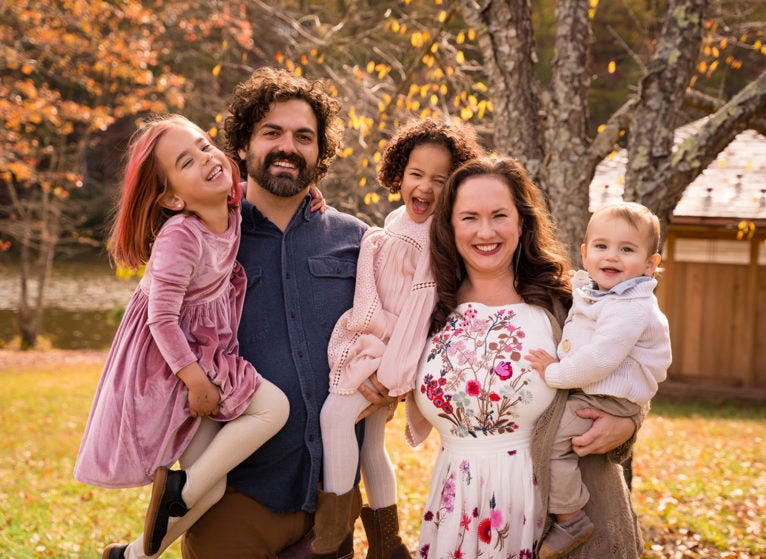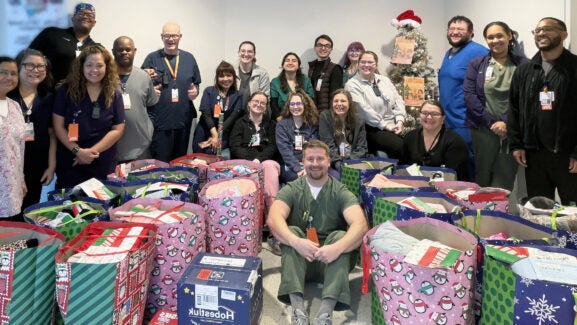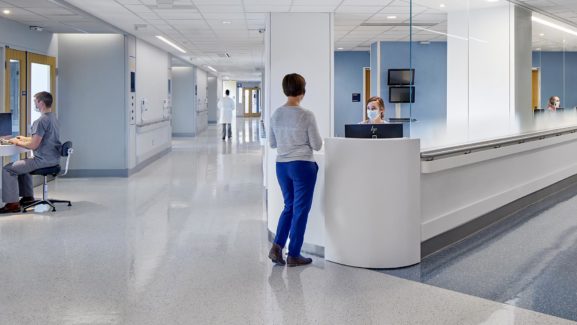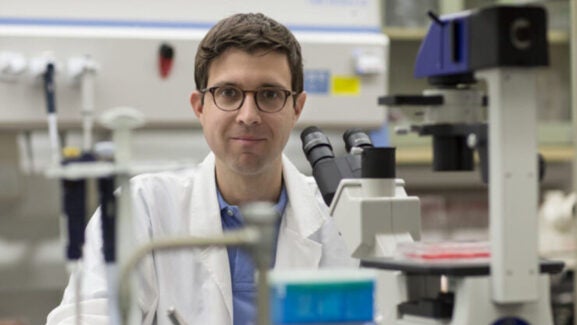

Stephanie McNerney and family. (Contributed photo.)
Turning Passion Into Practice, Stephanie McNerney Is Helping Improve Care for Foster Kids
Launched in January, the Village Care Program (VCP) is a new multidisciplinary program at UVA Children’s designed to meet the complex medical and mental health needs of kids in foster care, group homes, or other unique living situations. It was made possible thanks to one nurse practitioner who saw a need, took the initiative and turned her passion into practice. Below, Stephanie McNerney, MSN, PNP, RN, shares more about the program, the dedicated team of colleagues who helped make it a reality and her strong personal ties to the cause.
When did you arrive at UVA Health?
McNerney: I was a pediatric nurse for 10 years. I grew up here and went to grad school at UVA. My first nursing job was in California, and I came back to Charlottesville in 2005. I’ve been a nurse practitioner in developmental pediatrics since 2012.
Where did the idea for the Village Care Program initiate?
McNerney: My husband and I are trained foster parents, so I’ve seen firsthand how challenging it is for these families. It became apparent to me pretty quickly as we were navigating complicated medical and mental health issues for our 15-year-old foster daughter that the current system was really incomplete. Parenting is so hard at baseline, and it’s extra hard when you have a child who has experienced adversity and trauma — a lot goes into making sure they get the care they need. No one is prepared for that.
I was a person with access and privilege. I work at a children’s hospital. I knew the people she needed to see personally, and I could reach out to them. We work with amazing, caring, generous people, so I could make it happen. But even with that access, it was overwhelming to get her the care she needed and make sure people understood how trauma affected every part of her body. Everyone involved needed more understanding — even me.
Being a foster parent has been my greatest teacher, while simultaneously breaking my heart. The only thing you can control is saying yes or no to a placement. After that, you learn there is little control and you can’t anticipate the ways you will be stretched and grow.
Building support is the only way my family has been able to cope. I have a village; I have a partner, family in town, a community of friends, a job that’s secure, and I have medical knowledge. But there have been times when we felt like we were drowning because the need is so great. So if we need all of this support, think about families who have fewer resources. I saw the need to create a holistic program for these families. I want for them what I want for my own family: connection, healing and health.
Why did you and your husband decide to become foster parents?
McNerney: One of the things we bonded over early on was a strong desire to participate in our community. As we looked to start our own family, we decided that fostering kids would be a good way for us to meet a need, and it fit in with our own rhythm. We actually began our training before we had kids, so we didn’t know how we were going to be as parents. But I got pregnant soon after our training. And when our daughter Sparrow was about 10 months old, we got our first call from the social worker about a 15-year-old girl who needed a placement that day. She asked if we could accept her, and I said yes.
We’ve had two long-term placements, and we are still connected to both, one through adoption and the other through informal support. We also have a 20-month-old son — our COVID baby — so we’ve put things on hold.
How did you go about turning your idea for the program into reality?
McNerney: I did a few informal focus groups pre-COVID to discuss the current state of things. I met with foster parents in our community and asked: "What do you need to take care of your kids? What’s lacking?" I had get-togethers with other providers across disciplines — not just physicians and nurses, but social workers and therapists — people I heard through the grapevine had an interest in adoption and foster care, who cared about healthcare inequities and our community. There were a handful who actually fostered kids. Joining forces with others who cared about this too gave me a lot of life to move forward.
I wrote a proposal covering the current situation at UVA and in our community and why we need to take care of these kids differently. It outlined our current capacity and the need for a dedicated medical and mental health program for these families. I was asked to shorten this proposal into an SBAR [Situation Background Assessment Recommendation], a process for identifying opportunity in our system. Then I submitted the SBAR to my division head, Dr. Stevenson, and Dr. Moon, who was the head of general pediatrics at the time.
Leadership, everyone, agreed it was the right thing to do. If we could make it feasible, they’d support it. There were no resources available, so we had to build it from our current capacity. Dr. Billy Petersen was really helpful in determining how to structure the program within those constraints.
Pediatrician Dr. Amy Wrentmore and clinical psychologist Dr. Emily Gonzalez, who has personal experience with adoption and professional experience with foster care, were integral champions of this work and joined efforts to get it off the ground. Dr. Ann Kellams and [Senior Administrative Coordinator] Cody Ragland were immensely helpful as well.
We had a team that met weekly for 6 to 9 months to plan it, to build it. Of course, when COVID hit, everything paused. I had a baby. When I came back, we had to get everything going again, but we were given the chance to do it. Now, we are about 6 months in.
What are some key strategies you recommend when it comes to caring for kids in foster care or in another unique living situation?
McNerney: I think sometimes health professionals get overwhelmed by the complexity of the situation, the number of people in the room. There may be a biological parent, a foster parent, social worker, etcetera … so determining how to address different people can be challenging. When I come into a room, I address the child first. Get down on their level if they’re small. Introduce yourself. Create those non-verbal safety cues. Then I may ask how I should refer to everyone. Acknowledging the dignity of a person includes addressing them appropriately. I make sure to give the biological family a chance to respond to the questions first, and often they will be the ones to defer to the foster family for more input.
I know it can be uncomfortable at times, but we need to model behavior. We’re all here together to focus on the child. Often, we are too binary when it comes to kids in foster care. We simplify the situation by assuming the foster parent is the good parent and the bio parent is the bad parent. But it’s not that simple. In the United States, we have so much structurally that sets families up for failure and contributes to them not being able to care for their child. There’s so much we don’t know, and we need to have some humility, withhold judgement and just be there to advocate for the child. This includes assessing the fit of the foster family.
It's also important to understand that taking care of kids in welfare custody is going to take an extra layer of consideration and extra time to do your job well. This work is grounded in relationships. You may have to make additional calls to a social worker or a parent to be sure everyone has the information they need to best care for the child. You may need to see the child more often. The AAP recommends that children in and out of home care be seen much more frequently than the standard schedule for other pediatric patients.
Now that the program is up and running, how do you feel about the progress you’ve made?
McNerney: I feel really proud that our leadership supported this. But there’s still so much work to be done to support families in our community. Some days I’m really hopeful. And some days I feel despair. It’s kind of like being a foster parent. You have these undulating emotions all of the time, with joy and grief in the same space. But I am inspired to keep working.
I’m working hard to continue to build community relationships. There are so many different systems involved with foster kids. You have to talk to educators, biological families, the health department, therapists, community providers, child protection staff, attorneys and others. We could have the best program at UVA, but if we’re not partnering with others in our community, we would not be able to provide the level of support foster kids need to do well. It’s challenging, but it’s something I love about this work.
I keep dreaming and planning with my village, including Dr. Jen Andrews and Dr. Gonzalez, to create a true continuum of child protection and advocacy that prevents family disruption and harm. This would start in prevention (hello to my OBGYN/Teen Health colleagues!). It would encompass robust communication and authentic relationships with our community partners. It would include continued conversation around implicit bias and structural racism, cultural considerations, as well as trauma-informed practice all shaping our care for child welfare involved families. We have a way to go, but most days I think we are moving in the right direction.
Latest News




Stephanie you are a phenomenal human being! Thank you for the care and compassion you deliver to children, especially the most vulnerable. I am honored to know you!
I echo what Tina said! Phenomenal work from a phenomenal human being!!!
Stephanie, this is AMAZING work. Well done!
The insight and determination to bring the extra care that is needed to a special population is inspiring! Thank you for all that you have done and are doing for these kids.
Stephanie, you are absolutely amazing. I am honored to know you!
Stephanie, you go, girl! You are doing the good stuff. Thanks for dreaming big and making it happen.
Thank you for sharing, Stephanie! I feel so humbled to work with you, your passion transcends into the workplace.
Stephanie, your passion, drive, and accomplishments are exemplary!! I appreciate you for all you do and continue to do for this special population.